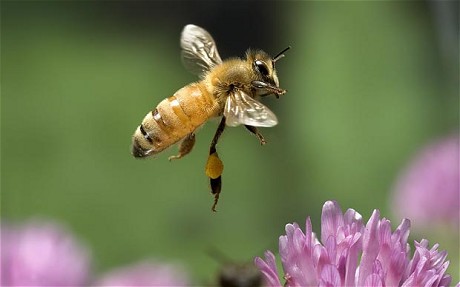|

by Ambrose Evans-Pritchard
20 February 2011
from
Telegraph Website
Spanish version
The bee crisis has been treated as a
niche concern until now, but as the UN's index of food prices hits
an all time-high, it is becoming urgent to know whether the plight
of the honey bee risks further exhausting our food security.

Between 80% and 90%
of animal pollination of crops comes from domesticated honey bees
Photo: GETTY
Almost a third of global farm output
depends on animal pollination, largely by honey bees.
These foods provide 35% of our calories, most of our minerals,
vitamins, and anti-oxidants, and the foundations of gastronomy. Yet
the bees are dying - or being killed - at a disturbing pace.
The story of "colony collapse disorder" (CCD) is already well-known
to readers.
Some keep hives at home and have experienced this mystery plague,
and doubtless have strong views on whether it is caused by
parasites, or a virus, or use of pesticides that play havoc with the
nervous system of young bees, or a synergy of destructive forces
coming together.
The bee crisis has been treated as a niche concern until now, but as
the UN's index of food prices hits an all time-high in real terms
(not just nominal) and grain shortages trigger revolutions in the
Middle East, it is becoming urgent to know whether the plight of the
honey bee risks further exhausting our already thin margin of food
global security.
The agri-business lender
Rabobank said the numbers of US bee
colonies failing to survive each winter has risen to 30% to 35%
from an historical norm of 10%. The rate is 20% or higher in much
of Europe, and the same pattern is emerging in Latin America and
Asia.
Albert Einstein, who liked to make bold claims (often wrong),
famously said that,
"if the bee disappeared off the
surface of the globe, man would have only four years to live".
Such "apocalyptic scenarios" are
overblown, said Rabobank.
The staples of corn, wheat, and rice are
all pollinated by wind.
However, animal pollination is essential for nuts, melons and
berries, and plays varying roles in,
citrus fruits, apples, onions,
broccoli, cabbage, sprouts, courgettes, peppers, aubergines,
avocados, cucumbers, coconuts, tomatoes and broad beans, as well as
coffee and cocoa.
This is the fastest growing and most valuable part of the global
farm economy.
Between 80% and 90% of pollination comes from
domesticated honey bees. Moths and butterflies lack the range to
penetrate large fields.
The reservoir of bees is dwindling to the point where ratios are
dangerously out of kilter, with the US reaching the "most extreme"
imbalance. Pollinated crop output has quadrupled since 1961, yet bee
colonies have halved.
The bee-per-hectare count has fallen
nearly 90%.
"Farmers have managed to produce
with relatively fewer bee colonies up to this point, and there
is no evidence of agricultural yields being affected. The
question is how much further this situation can be stretched,"
said the report.
Rabobank said US bee colonies were
shrinking even before CCD struck because cheap imports of Asian
honey had undercut US hives.
Note the parallel with the demise of the
US rare earth metals industry, put out of business when China
flooded the world with cheaper supplies in the 1990s. This is what
happens when free trade is managed carelessly.
China has its own problems. Pesticides used in pear orchards wiped
out bees in parts of Sichuan in the 1980s. Crops are now pollinated
by hand using feather brushes, a laborious process as one bee colony
can pollinate up to 300 million flowers a day.
Germany, France and Italy have banned some pesticides, especially
neonicotinoids (as in tobacco) that harm the memories of bees.
The British Beekeepers' Association has called for an "urgent
review" of these chemicals, fearing we may lose all our bees within
a decade if we are not careful. US beekeepers have made similar
pleas. The US agriculture department's Bee Research Laboratory has
found evidence that even low levels of these pesticides reduce the
resistance of bees to fungal pathogens.
Leaked documents from the Environmental Protection Agency
(EPA) confirm that
clothianidin used on corn seed is "highly toxic",
may pose a "long-term risk" to bees, and that previous tests were
flawed.
Critics alleged a cover-up
Rabobank said we should be careful not
to vilify agro-industry.
The world needs food and fertilizer
companies to keep finding ways to raise crop yields, if we are to
feed over 70m extra mouths each year, and meet the demands of Asia's
diet revolution, offset water scarcity in China and India, and
divert a great chunk of the US, Argentine, and EU grain harvest into
bio-fuels for cars.
With pincers closing in on world food output from so many sides, we
have little margin for error. Scientists are coming to the rescue.
Research is honing in on the
spore Nosema, and the
Varroa mite, but
not fast enough.
Rabobank calls for a step-change in the global response, and in the
meantime for tougher rules, so that beekeepers do not have to fight
alone, starting with curbs on pesticide use during in daylight hours
when bees are foraging.
Apian atrophy is a more immediate threat than 'global warming,' and
can be solved, yet has barely risen onto the policy radar screen.
This is surely a misjudgment.
Einstein was not always wrong...
|

